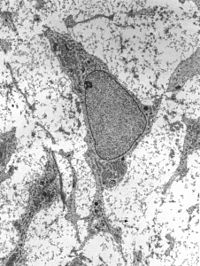
A Method for Encapsulation and Transplantation into Diabetic Mice of Human Induced Pluripotent Stem Cells (hiPSC)-Derived Pancreatic Progenitors.
Sign Up to like & getrecommendations! Published in 2021 at "Methods in molecular biology"
DOI: 10.1007/7651_2021_356
Abstract: Pancreatic islet endocrine cells generated from patient-derived induced pluripotent stem cells represent a great strategy for both disease modeling and regenerative medicine. Nevertheless, these cells inherently miss the effects of the intricate network of systemic… read more here.
Keywords: pluripotent stem; induced pluripotent; diabetic mice; stem cells ... See more keywords

Phosphorylation of NEUROG3 Links Endocrine Differentiation to the Cell Cycle in Pancreatic Progenitors.
Sign Up to like & getrecommendations! Published in 2017 at "Developmental cell"
DOI: 10.1016/j.devcel.2017.02.006
Abstract: During pancreatic development, proliferating pancreatic progenitors activate the proendocrine transcription factor neurogenin 3 (NEUROG3), exit the cell cycle, and differentiate into islet cells. The mechanisms that direct robust NEUROG3 expression within a subset of progenitor… read more here.
Keywords: cell cycle; differentiation; progenitor; cell ... See more keywords

GP2-enriched pancreatic progenitors give rise to functional beta cells in vivo and eliminate the risk of teratoma formation.
Sign Up to like & getrecommendations! Published in 2022 at "Stem cell reports"
DOI: 10.1016/j.stemcr.2022.03.004
Abstract: Human pluripotent stem cell (hPSC)-derived pancreatic progenitors (PPs) can be differentiated into beta-like cells in vitro and in vivo and therefore have therapeutic potential for type 1 diabetes (T1D) treatment. However, the purity of PPs varies across… read more here.
Keywords: gp2 enriched; gp2; pancreatic progenitors; give rise ... See more keywords

Long-term feeder-free culture of human pancreatic progenitors on fibronectin or matrix-free polymer potentiates β cell differentiation.
Sign Up to like & getrecommendations! Published in 2022 at "Stem cell reports"
DOI: 10.1016/j.stemcr.2022.03.013
Abstract: With the aim of producing β cells for replacement therapies to treat diabetes, several protocols have been developed to differentiate human pluripotent stem cells to β cells via pancreatic progenitors. While in vivo pancreatic progenitors expand… read more here.
Keywords: human pancreatic; term feeder; long term; pancreatic progenitors ... See more keywords

In vivo Environment Swiftly Restricts Human Pancreatic Progenitors Toward Mono-Hormonal Identity via a HNF1A/HNF4A Mechanism
Sign Up to like & getrecommendations! Published in 2020 at "Frontiers in Cell and Developmental Biology"
DOI: 10.3389/fcell.2020.00109
Abstract: Generating insulin-producing β-cells from human induced pluripotent stem cells is a promising cell replacement therapy for improving or curing insulin-dependent diabetes. The transplantation of end-stages differentiating cells into living hosts was demonstrated to improve β-cell… read more here.
Keywords: human pancreatic; vivo environment; hnf1a hnf4a; identity ... See more keywords

Single-cell profiling of GP2-enriched pancreatic progenitors to simultaneously create acinar, ductal, and endocrine organoids
Sign Up to like & getrecommendations! Published in 2023 at "Theranostics"
DOI: 10.7150/thno.78323
Abstract: Rationale: Pancreatic lineage specification follows the formation of tripotent pancreatic progenitors (PPs). Current protocols rebuilding PPs in vitro have an endocrine lineage bias and are mostly based on PDX1/NKX6-1 coexpression neglecting other markers decisive for… read more here.
Keywords: cell; expression; single cell; lineage ... See more keywords